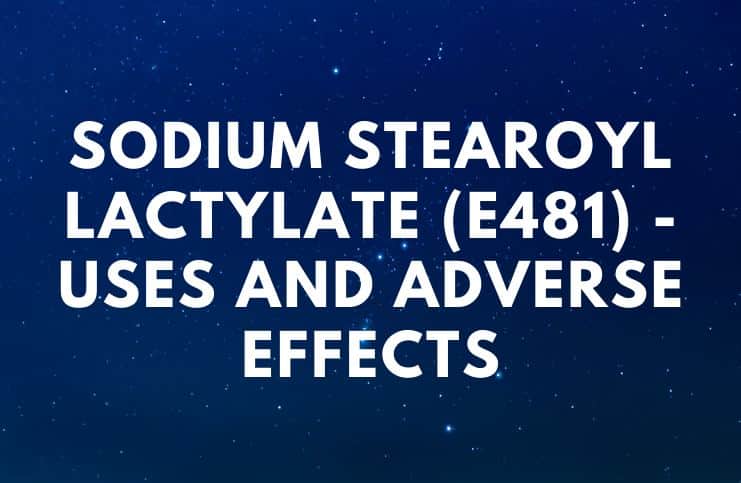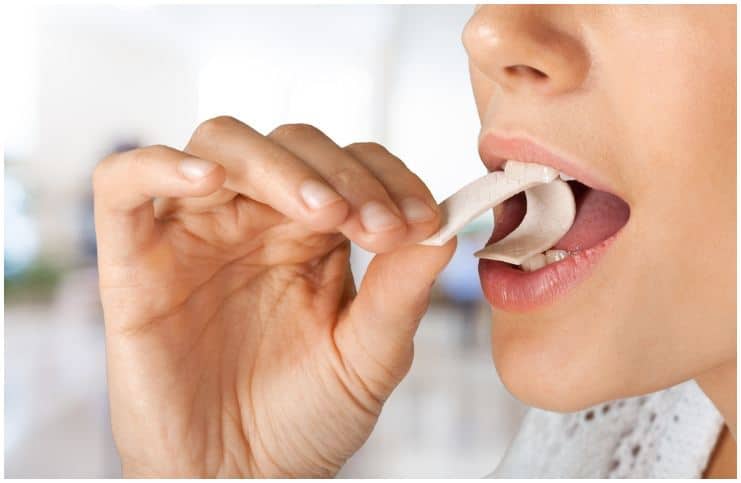Sodium Stearoyl Lactylate (E481) – Adverse Effects:
Sodium stearoyl lactate, also known as SSL or E481, is a slightly yellowish powder FDA-approved food additive.
It is chemically synthesized by combining stearic and lactic acid and sodium hydroxide (caustic soda), which is also used in desserts and baked goods.
This class is known as the lactylates and includes a variety of different compounds, including another food additive – calcium stearoyl lactylate (or E482).
SSL is slightly hygroscopic (meaning it retains moisture), soluble in hot oil or fat or in ethanol, and dispersible in warm water. This compound mixes liquids and oils together, helps strengthen the dough, and can replace some amount of sugar and fat.
It is considered to be a non-toxic additive by the U.S. Food and Drug Administration and is permitted for direct addition to food for human consumption.
Moreover, it is an approved food additive according to the EU with ”E” number E 481.
Is SSL A Vegan Substance?
Stearic acid is a fatty acid that may be produced by the chemical process of hydrogenation of unsaturated vegetable oils or animal fat.
Lactic acid is usually produced from bacterial fermentation, for example, fermented soy products or milk fermentation. In addition, these ingredients do not contain milk protein.
Therefore, if you are vegan, take note that this food additive can be sourced from both vegetable and animal sources, although in practice nearly always vegetable sources will be used.
Uses
E481 is used in a wide variety of products such as – baked goods (in an amount that mustn’t exceed 0.5 percent by weight of flour used), cream liqueurs, instant rice, toppings, puddings, cereals, icings, canned meats, dietetic foods, dehydrated potatoes, waffles, chewing gum, pancakes, desserts, pasta, fillings, pet foods.
Furthermore, it is also used in personal care products (in concentrations of 0.5-10 percent by weight of the formula it is in), like shaving creams or facial, hand, and foot moisturizers.
It can be used for:
- dough conditioning – makes the gluten (plant protein) in bread stronger, also increasing the volume of the loaf;
- increased shelf life – keeps mold away;
- reduced fat used in bread by dispersing the fats, making it softer;
- due to its sweet taste, it can replace sugar;
- it improves the efficiency of fermentation and slicing of the finished bread product;
- emulsifying – it helps keep oil and water mixed together. For instance, it absorbs the water in baked goods, thus allowing for more water to be used.
Dosage
As this food additive is believed to be safe, there is no official limit on the dosage of intake. Nevertheless, we recommend consulting a healthcare specialist before using a large quantity of E481 for long periods.
Precautions & Side Effects of Sodium Stearoyl Lactylate
Important note – there is no evidence that SSL could have any side negative effects on children, newborns, or pregnant women. Nevertheless, don’t forget that this is, after all, a chemical substance, so it should be avoided as much as possible.
There is a lack of data available on human carcinogenicity, toxicity, mutagenicity, teratogenicity, and developmental toxicity.
However, it may cause a slight irritation to the skin, and at elevated temperatures, direct contact with this product can cause thermal burns. It may also be slightly irritating to the respiratory tract.
There is some small incidence of allergies (contact dermatitis) to this substance. This causes the body to release inflammatory chemicals, which can make the skin feel irritated and itchy.
Moreover, in the case of direct contact with the eyes, promptly flush the eyes with warm water for at least 15 minutes.
Another possible adverse effect of SSL is food intolerance – the “inability to properly digest or fully process certain foods,“ which leads to illness and chronic symptoms. It is essential to know that food intolerance is different from food allergy.
For example, unlike allergic reactions, food intolerances can be delayed up to 72 hours and vary in severity, affecting digestion, joints, skin, energy levels, respiration, and even psychological health.
According to statistics, more than 33 million adults in the US have food allergies.
Symptoms of food intolerance may include:
- hives;
- bloating;
- skin rash;
- irritable bowel;
- migraines;
- stomach ache;
- nausea;
- feeling under the weather;
- headaches;
- a runny nose;
- a cough.
READ THIS NEXT:
Casomorphin and Addiction to Cheese?
Citric Acid (E331) – Uses And Side Effects
References http://www.sciencelab.com/msds.php?msdsId=9925041 https://www.efsa.europa.eu/en/efsajournal/pub/3144 https://www.ncbi.nlm.nih.gov/pubmed/16033408



Yeah I seem to have responses mostly similar to this to this chemical or very similar notable foods that also tend to carry this chemical. My wife also although perhaps slightly less. Odd. Sure hope it doesn’t kill me one day. Perhaps some individuals are hyper sensitive?
“There is no evidence of risk” how much human study they did? Is there a lack of possibly applicable volunteers?